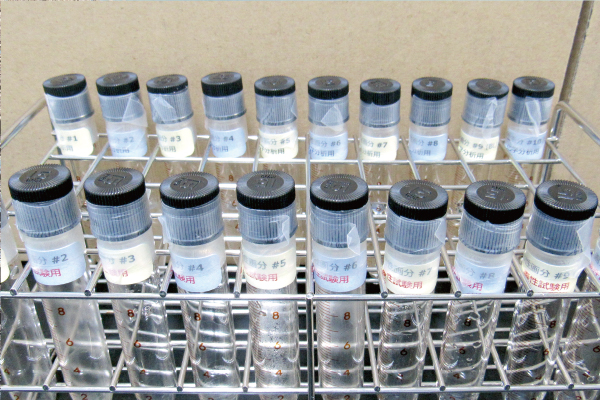Environmental Chemistry Lab, Department of Applied Chemistry,
Faculty of Science and Technology, Keio University
Led by Tomoaki OKUDA, Ph.D.
Research
Home > Research > Highlights [Toxicity Assessment of Particulate Matter]
Highlights
- Toxicity Assessment of Particulate Matter
- Worldwide Application of Our Environmental Research
- Particle Charging State
- Environmental Issues in Subway Stations and Enclosed Spaces
- Super Practical Human and Environmental Research enforcing Application and Social Implementation
Toxicity Assessment of Particulate Matter
Atmospheric aerosols such as fine particles are of serious concern for human health. However, the components of particulate matter responsible for the adverse health effects are not yet fully understood. We try to elucidate these parameters of atmospheric aerosols by developing original measurement methods based on atmospheric chemistry and aerosol engineering.
CYCLEX Project
From an experimental point of view, a large amount of particulate matter, in this case tens to hundreds of mg of particulate matter, is needed to evaluate the adverse effects on human health (in both in vivo and/or in vitro studies). However, it is difficult to collect a sufficient amount of particulate matter by conventional filter collection methods where particulate matter is collected on a filter. In many previous studies particulate matter is extracted from a filter, then exposed to the test cell or animal. However, these experiments using PM extracts provide results that might not reflect the actual biological response due to differing extraction efficiency and loss of PM constituents. More importantly, the extract is not pure particulate matter itself, given filter contamination. We developed a hybrid virtual-impactor/cyclone high-volume simultaneous sampler for fine and coarse particles (K-ViC: Keio-Virtual Impactor with Cyclones) that enables us to collect a sufficient amount of crude PM (fine and coarse particles themselves) for in vivo and/or in vitro assays. Under the three-year project called CYCLEX (Cyclone collection of PM2.5 followed by Exposure Experiments) from 2016 to 2019, we installed our sampler in Yokohama (on our campus), Saitama and Fukuoka. The particulate matter collected as a powder has been subjected to in vivo/in vitro assays at Kyoto University. We are working to enhance this project to include gene expression analysis and more detailed biochemical data after particle exposure.
Snap Shots
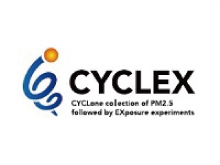 This is the logo of the CYCLEX project launched in June 2016, supported by the Environment Research and Technology Development Fund (5-1651) of the Environmental Restoration and Conservation Agency of Japan.
This is the logo of the CYCLEX project launched in June 2016, supported by the Environment Research and Technology Development Fund (5-1651) of the Environmental Restoration and Conservation Agency of Japan.
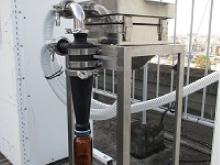 This is the prototype of the high-volume cyclone sampler, called K-RiC (Keio-Real Impactor with Cyclone). Publication #47 describes the details of this sampler.
This is the prototype of the high-volume cyclone sampler, called K-RiC (Keio-Real Impactor with Cyclone). Publication #47 describes the details of this sampler.
 The methodology of the K-ViC sampler has been refined several times.
The methodology of the K-ViC sampler has been refined several times.
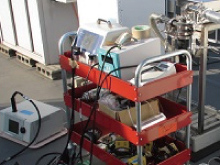 We use many measurement instruments such as SMPS, APS, and OPC in order to evaluate the sampler performance.
We use many measurement instruments such as SMPS, APS, and OPC in order to evaluate the sampler performance.
Toxicity evaluation of particulate matter collected with cyclone by measuring the oxidative potential
Oxidative potential (OP) is one of the chemical parameters related to the biological effects of atmospheric particulate matter. Many studies have been conducted regarding OP of particulate matter collected by conventional filter sampling. In this study, we are measuring the OP of powder collected by cyclones in order to simultaneously analyze the chemical characteristics of particulate matter and exposure assessment. DTT (Dithiothreitol) Assay, which is generally used when measuring the oxidizing ability of particulate matter, and AA (Ascorbic Acid) Assay using ascorbic acid, which is a physiological antioxidant abundant in the human body, are used in this study.
Snap Shots
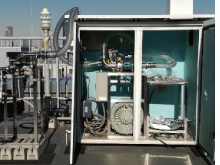 A hybrid virtual-impactor/cyclone high-volume simultaneous sampler for fine and coarse particles (K-ViC: Keio-Virtual Impactor with Cyclones). The cyclones and impactor are on the left, and the pump and flow meter are on the right.
A hybrid virtual-impactor/cyclone high-volume simultaneous sampler for fine and coarse particles (K-ViC: Keio-Virtual Impactor with Cyclones). The cyclones and impactor are on the left, and the pump and flow meter are on the right.
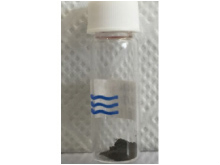 The sample was obtained by using the system as a powder form. This is used for AA Assay experiments.
The sample was obtained by using the system as a powder form. This is used for AA Assay experiments.
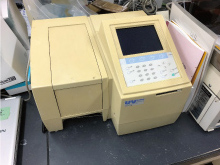 This is a spectrophotometer for measuring the amount of ascorbic acid.
This is a spectrophotometer for measuring the amount of ascorbic acid.
Biochemical Toxicity Evaluation of Particulate Matter
Chemical and biological components are considered as important parameters related to the toxicity of particulate matter. Although there are many studies focusing on the chemical components of particles, there have been few studies focusing on both of biological and chemical components. The projects we have been working on so far have revealed that the toxicity of particles cannot be explained solely by their chemical characteristics, and that biological components are also significantly related. Among the biological components, endotoxin (or LPS: Lipopolysaccharide), which constitutes the cell wall of Gram-negative bacteria, is known to induce oxidative stress in cells, causing inflammatory reactions, and cell/organ damage. β-glucan, a constituent of the fungal cell wall, has also been linked to the harmful effects of particles. The purpose of this study is to clarify the toxicity of atmospheric particulate matter from a biochemical point of view by quantifying endotoxin and β-glucan in particulate matter simultaneously with many chemical components.
Snap Shots
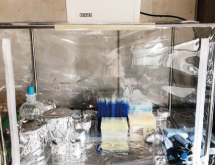 Conducting experiments using a clean bench.
Conducting experiments using a clean bench.
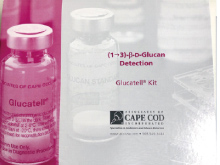 This is the kit for LAL Assay.
This is the kit for LAL Assay.
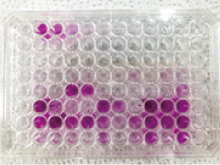 The darker the color, the higher the endotoxin concentration.
The darker the color, the higher the endotoxin concentration.
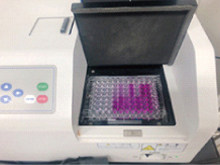 Measuring absorbance using a microplate reader.
Measuring absorbance using a microplate reader.
Chemical Speciation of Metals in Atmospheric Particulate Matter Collected with Cyclone by XAFS Method
Atmospheric particulate matter is a serious concern regarding human health. Moreover, it is necessary to focus not only on particle mass but also chemical composition to understand aerosol toxicity. We focused on metals, such as chromium which shows different toxicity depending on its oxidation state. Conventional methods such as sequential extraction have been used to conduct chemical speciation of particulate matter, but the sensitivity of those methods are generally lower. We carried out the chemical speciation using a X-ray absorption fine structure (XAFS) method, which has much higher sensitivity.
Snap Shots
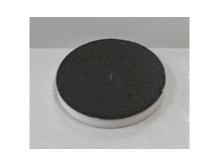 A layered pellet made with aerosol particles and cellulose powder.
A layered pellet made with aerosol particles and cellulose powder.
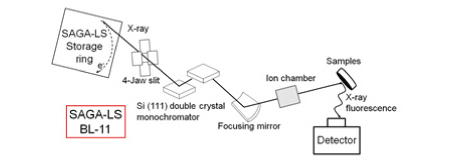 XAFS spectra were obtained at BL-11 at the Kyusyu Synchrotron Light Research Center (SAGA-LS). Spectra were usually measured using fluorescence mode.
XAFS spectra were obtained at BL-11 at the Kyusyu Synchrotron Light Research Center (SAGA-LS). Spectra were usually measured using fluorescence mode.
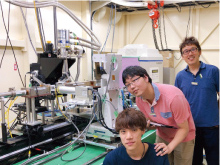 Photo of the experimental device. Usually we conduct 2 day long experiments.
Photo of the experimental device. Usually we conduct 2 day long experiments.
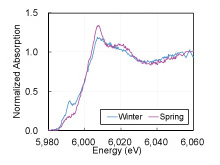 The spectra obtained from the samples differed depending on where and when the samples were collected.
The spectra obtained from the samples differed depending on where and when the samples were collected.
Development of a Movable Cyclone Sampler for Toxicity Evaluation of Particulate Matter
We have developed the high-volume cyclone samplers such as K-ViC and K-RiC for aerosol collection. These samplers are quite useful, however they are too heavy for field work. This study aims to develop much smaller movable cyclone sampler to collect aerosol particles at any sites, followed by toxicity evaluation of particulate matter.
Snap Shots
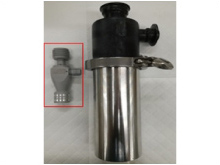 (Right) the cyclone for K-ViC and K-RiC, and (left) the small cyclone to be installed in the movable cyclone sampler.
(Right) the cyclone for K-ViC and K-RiC, and (left) the small cyclone to be installed in the movable cyclone sampler.
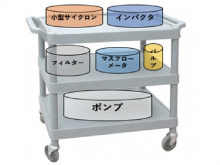 This is a conceptual diagram of a movable cyclone sampler.
This is a conceptual diagram of a movable cyclone sampler.
Research
Vision
Research Topics
Publications
Research Grants


